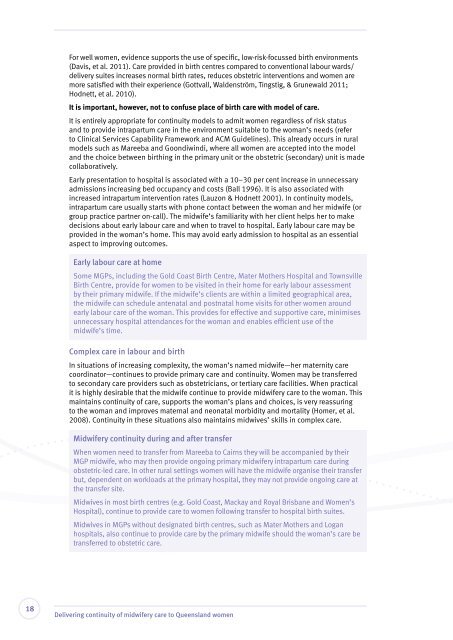Delivering continuity of midwifery care to Queensland women
Delivering continuity of midwifery care to Queensland women
Delivering continuity of midwifery care to Queensland women
You also want an ePaper? Increase the reach of your titles
YUMPU automatically turns print PDFs into web optimized ePapers that Google loves.
For well <strong>women</strong>, evidence supports the use <strong>of</strong> specific, low-risk-focussed birth environments<br />
(Davis, et al. 2011). Care provided in birth centres compared <strong>to</strong> conventional labour wards/<br />
delivery suites increases normal birth rates, reduces obstetric interventions and <strong>women</strong> are<br />
more satisfied with their experience (Gottvall, Waldenström, Tingstig, & Grunewald 2011;<br />
Hodnett, et al. 2010).<br />
It is important, however, not <strong>to</strong> confuse place <strong>of</strong> birth <strong>care</strong> with model <strong>of</strong> <strong>care</strong>.<br />
It is entirely appropriate for <strong>continuity</strong> models <strong>to</strong> admit <strong>women</strong> regardless <strong>of</strong> risk status<br />
and <strong>to</strong> provide intrapartum <strong>care</strong> in the environment suitable <strong>to</strong> the woman’s needs (refer<br />
<strong>to</strong> Clinical Services Capability Framework and ACM Guidelines). This already occurs in rural<br />
models such as Mareeba and Goondiwindi, where all <strong>women</strong> are accepted in<strong>to</strong> the model<br />
and the choice between birthing in the primary unit or the obstetric (secondary) unit is made<br />
collaboratively.<br />
Early presentation <strong>to</strong> hospital is associated with a 10–30 per cent increase in unnecessary<br />
admissions increasing bed occupancy and costs (Ball 1996). It is also associated with<br />
increased intrapartum intervention rates (Lauzon & Hodnett 2001). In <strong>continuity</strong> models,<br />
intrapartum <strong>care</strong> usually starts with phone contact between the woman and her midwife (or<br />
group practice partner on-call). The midwife’s familiarity with her client helps her <strong>to</strong> make<br />
decisions about early labour <strong>care</strong> and when <strong>to</strong> travel <strong>to</strong> hospital. Early labour <strong>care</strong> may be<br />
provided in the woman’s home. This may avoid early admission <strong>to</strong> hospital as an essential<br />
aspect <strong>to</strong> improving outcomes.<br />
Early labour <strong>care</strong> at home<br />
Some MGPs, including the Gold Coast Birth Centre, Mater Mothers Hospital and Townsville<br />
Birth Centre, provide for <strong>women</strong> <strong>to</strong> be visited in their home for early labour assessment<br />
by their primary midwife. If the midwife’s clients are within a limited geographical area,<br />
the midwife can schedule antenatal and postnatal home visits for other <strong>women</strong> around<br />
early labour <strong>care</strong> <strong>of</strong> the woman. This provides for effective and supportive <strong>care</strong>, minimises<br />
unnecessary hospital attendances for the woman and enables efficient use <strong>of</strong> the<br />
midwife’s time.<br />
Complex <strong>care</strong> in labour and birth<br />
In situations <strong>of</strong> increasing complexity, the woman’s named midwife—her maternity <strong>care</strong><br />
coordina<strong>to</strong>r—continues <strong>to</strong> provide primary <strong>care</strong> and <strong>continuity</strong>. Women may be transferred<br />
<strong>to</strong> secondary <strong>care</strong> providers such as obstetricians, or tertiary <strong>care</strong> facilities. When practical<br />
it is highly desirable that the midwife continue <strong>to</strong> provide <strong>midwifery</strong> <strong>care</strong> <strong>to</strong> the woman. This<br />
maintains <strong>continuity</strong> <strong>of</strong> <strong>care</strong>, supports the woman’s plans and choices, is very reassuring<br />
<strong>to</strong> the woman and improves maternal and neonatal morbidity and mortality (Homer, et al.<br />
2008). Continuity in these situations also maintains midwives’ skills in complex <strong>care</strong>.<br />
Midwifery <strong>continuity</strong> during and after transfer<br />
When <strong>women</strong> need <strong>to</strong> transfer from Mareeba <strong>to</strong> Cairns they will be accompanied by their<br />
MGP midwife, who may then provide ongoing primary <strong>midwifery</strong> intrapartum <strong>care</strong> during<br />
obstetric-led <strong>care</strong>. In other rural settings <strong>women</strong> will have the midwife organise their transfer<br />
but, dependent on workloads at the primary hospital, they may not provide ongoing <strong>care</strong> at<br />
the transfer site.<br />
Midwives in most birth centres (e.g. Gold Coast, Mackay and Royal Brisbane and Women’s<br />
Hospital), continue <strong>to</strong> provide <strong>care</strong> <strong>to</strong> <strong>women</strong> following transfer <strong>to</strong> hospital birth suites.<br />
Midwives in MGPs without designated birth centres, such as Mater Mothers and Logan<br />
hospitals, also continue <strong>to</strong> provide <strong>care</strong> by the primary midwife should the woman’s <strong>care</strong> be<br />
transferred <strong>to</strong> obstetric <strong>care</strong>.<br />
18<br />
<strong>Delivering</strong> <strong>continuity</strong> <strong>of</strong> <strong>midwifery</strong> <strong>care</strong> <strong>to</strong> <strong>Queensland</strong> <strong>women</strong>
















